What Works of Art Was Leonardo Da Vinci Famous for
Leonardo da Vinci was a famous renaissance creative person who created many paintings, sculptures and inventions.
Da Vinci's paintings are some of the greatest ever created and describe millions of viewers worldwide every twelvemonth.
He is considered to be ane of the well-nigh intelligent people of all time. His intelligence and talent had a profound bear on on Western civilisation and had a dramatic outcome on the course of compages, art, science and technology for centuries to come up.
Da Vinci was built-in in Italia on 15 April 1452. He was the son of a legal notary, Ser Piero da Vinci, and his wife, Caterina. He died in Amboise, France on ii May 1519 at the age of 67.
Leonardo da Vinci achieved a lot in his life, but he never married or produced any heirs that are known most.
He experimented with many types of media including paint, bronze, wax modeling and sculpting marble.
Leonardo da Vinci's Famous Paintings
1. Mona Lisa
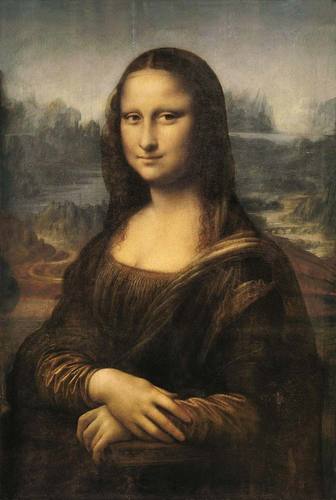
Leonardo da Vinci'south painting has always been 1 of the virtually captivating paintings in the world. It is also one of the most reproduced paintings in the world, with endless reproductions done in various sizes and media.
Mona Lisa is a portrait of Lisa del Giocondo, wife of Francesco del Giocondo, and mother of their 2 children. Leonardo da Vinci started working on information technology around 1503-1505 and finished it in 1519. The painting is currently located at the Louvre Museum in Paris which was founded by Louis Xiv – Rex of France in 1637.
It is difficult to believe that this painting was washed 400 years ago when information technology looks and so perfect today.
Within the art world, it is regarded as a masterpiece, but information technology simply became well-known to the general public when it was stolen from the Louvre in 1911 by an Italian employee called Peruggia.
Peruggia, equally an Italian nationalist, felt that the masterpiece should be restored to Italy and shown in an Italian public gallery rather than a French ane.
It was found and later returned to the Louvre, where thousands of people queue to view every calendar week.
2. The Last Supper

The Last Supper is one of the most recognizable works in the world. For many people this painting symbolizes the Christian sacrament and its significance. The Terminal Supper is non just a singular piece of work of fine art but also a masterpiece in the history of art and culture and is one of the greatest frescoes e'er fabricated.
However, information technology is not your standard fresco that is frequently painted on walls; instead, Leonardo chose to utilize his favored oil paints.
Leonardo is believed to have preferred oil because it dries slowly, allowing him to brand adjustments and accept a more deliberate approach to his work.
Leonardo recognized that if he was going to employ oil paints, the natural dampness that penetrates most stone wall structures would have to be sealed, or else his work would be ruined.
He countered this with a second blanket of gesso, mastic, and pitch.
Several times during its lengthy being, the artwork has had to be repaired.
Very little of the original acme coat of oil painting remains as a outcome of both environmental and deliberate deterioration.
3. The Annunciation
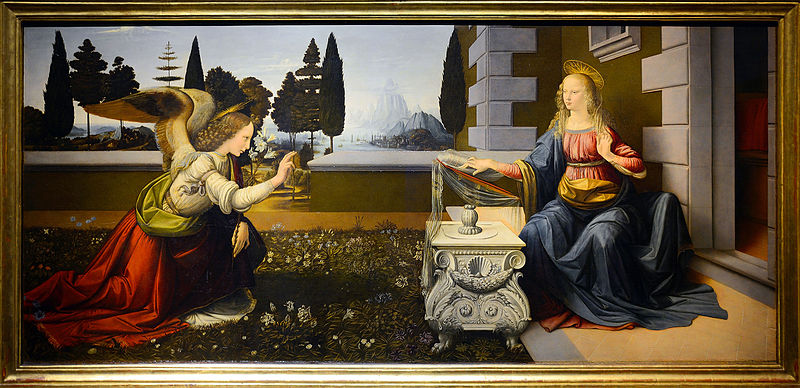
Announcement is an oil and tempura on wood artwork from the 1472–1475 period. Information technology is located in Florence, Italian republic's Uffizi gallery.
Leonardo may have completed the Annunciation in his early twenties while still working in the workshop of Andrea del Verrocchio, whom he had been an apprentice to as a youngster.
Leonardo da Vinci is famous for his paintings that depict biblical events in an interesting. In The Annunciation we can see a lot of symbolism and hidden meanings.
At that place are many details in the painting that have been used to convey the story behind it. For example, at that place is a lot of symmetry, balance and divine forces in this painting which symbolizes holiness and divinity – qualities that are associated with angels who visited Mary.
The painting reflects many commonalities with other Leonardesque paintings such as "Virgin of the Rocks" and "Saint John the Baptist".
4. Vitruvian Homo
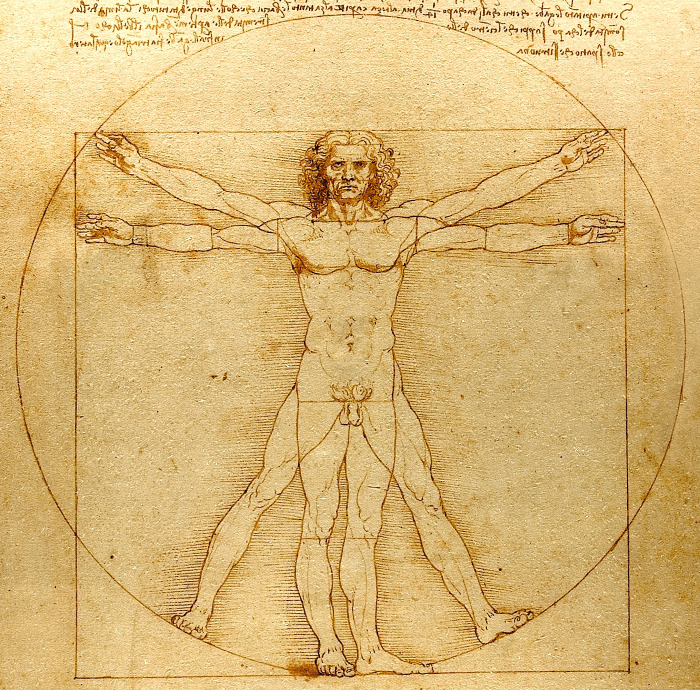
One of the most recognizable images in globe the, The Vitruvian Human being, has been reproduced on thousands of posters, prints, towels and a host of other products.
Leonardo da Vinci's most famous drawing, is a an ink on paper cartoon of a human inside a circumvolve and square that illustrate proportions of the human being body.
Made sometime between 1487 and 1490, it was idea to be lost until it was discovered in 1500 in da Vinci's notebooks. The drawing is named after Marcus Vitruvius Pollio, the author of De Architectura who wrote near human proportions while comparing them to architectural principles.
This drawing shows the symmetry in every person by demonstrating how these proportions relate to Leonardo's idea that man was created in God's image.
It is housed at the Gabinetto dei disegni e delle stampe of the Gallerie dell'Accademia, in Venice, Italian republic. It, like other works on paper, is but shown to the public on rare occasions, thus it is non part of the museum's regular exhibition.
Information technology was recently on exhibition in the Louvre equally part of an agreement between French republic and Italy, from 24 Oct 2019 until 24 Feb 2020.
5. The Virgin and Child with St. Anne and St. John the Baptist
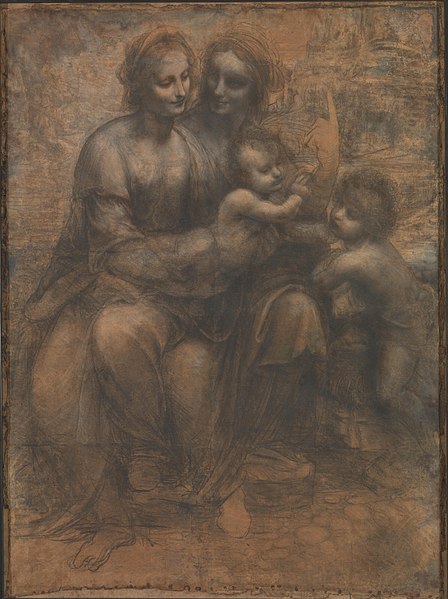
The Virgin and Kid with St. Anne and St. John the Baptist is a large charcoal, blackness and white chalk drawing on 8 pieces of paper that are stuck together to form one large drawing.
Information technology is speculated that it is a written report or "cartoon" for a big painting, yet no such painting exists. It is occasionally referred to as The Burlington Business firm Cartoon due to information technology existence housed in the Regal University in London which is situated in Burlington Business firm.
It was in one case attacked past a mentally sick man with a shotgun, who damaged the glass roofing it and the drawing itself, it has since been restored.
6. Salvatore Mundi
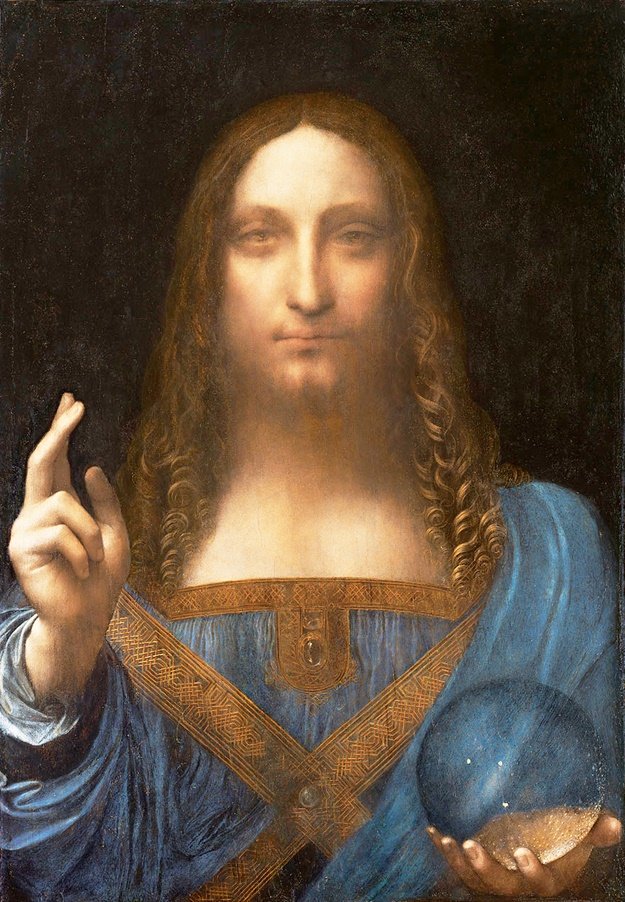
Leonardo da Vinci's Salvator Mundi is 1 of the near expensive paintings of all fourth dimension. It was sold for $450 million to Saudi Prince Bader bin Abdullah bin Mohammed bin Farhan al Safadi at Christie's auction in New York Urban center on Nov 15, 2017.
The artwork, which dates from almost 1500, had been lost to history for more than 200 years, had been damaged and poorly repaired, and had been sold and resold equally a minor work.
Salvator Mundi was supposed to brand its public premiere in September 2018 at the Louvre Abu Dhabi, but the museum abruptly postponed the presentation, and the artwork hasn't been seen in public since.
7. Lady with an Ermine
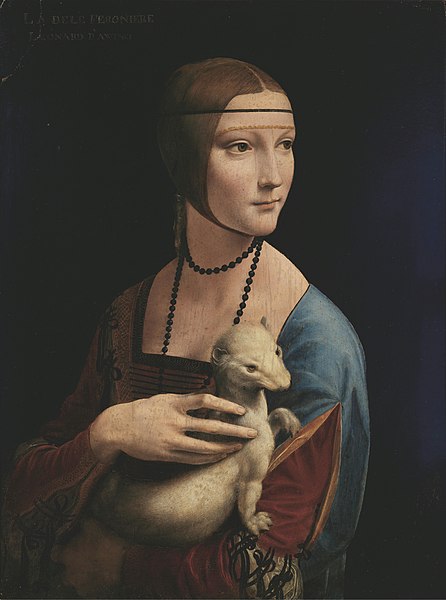
The story behind the Lady with an Ermine is that information technology was deputed by Ludovico Sforza's mistress, Cecilia Gallerani, for her private collection. The story also states that she posed for Leonardo da Vinci when he was working on this piece.
The painting depicts a lady seated with her mitt over her lap, while holding an ermine in her other hand. Lady with an Ermine is considered to be one of Leonardo da Vinci's most famous portraits for its beauty and the mystery backside it.
The composition is a pyramidic spiral, like in many of Leonardo's works, and the sitter is caught in the action of moving to the left, illustrating Leonardo's lifelong business organisation with the dynamics of movement.
8. Virgin of the Rocks
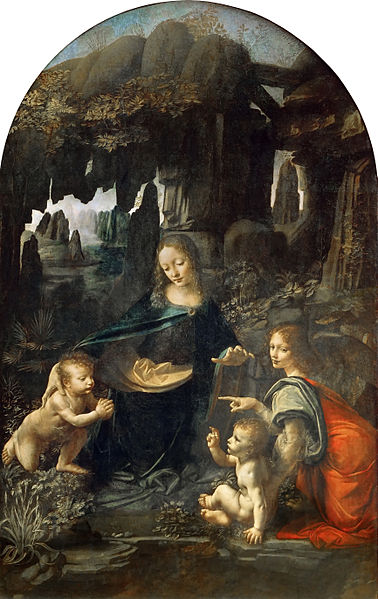
Da Vinci painted 2 versions of the Virgin of the Rocks. The version above is considered the 'prime version'(the first or earliest) and currently hangs in the Louvre, the 2d version is oft referred to as the London Virgin of the Rocks hangs in the National Gallery in London.
Both versions were originally oil on wood panel but the Louvre version has been transferred to canvas by French restorer Fr Hacquin in roughly 1806.
2 more than paintings are connected with the commission: side panels, each with an angel playing a musical musical instrument and finished past Leonardo's colleagues. Both are on display in the National Gallery in London.
Both paintings describe the Madonna and Child, equally well as the baby John the Baptist and an angel, on a rocky groundwork, which gives the works their mutual proper name. Except for two minor differences, the compositions of each are well-nigh identical.
The major compositional changes are in the angel's gaze and right hand. At that place are many small differences between the paintings, including the colors, lighting, vegetation, and the way Leonardo utilized sfumato in the Louvre version.
9. Portrait of Ginevra de' Benci
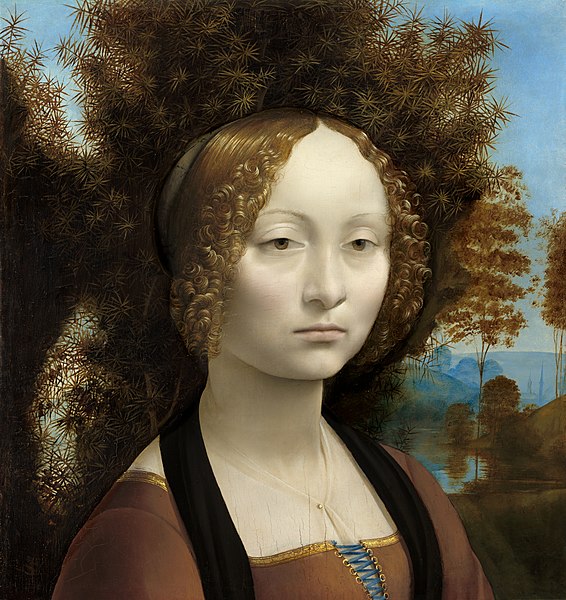
Ginevra de' Benci is a 15th-century portrait painting by Leonardo da Vinci depicting the Florentine noblewoman Ginevra de' Benci.
It is Leonardo'south only painting on the American continent, and it is the outset of only three known portraits of women he painted, the others beingness Woman with an Ermine in Krakow and the Mona Lisa at the Louvre in Paris.
Different Leonardo's other portraits of women, she has an most indifferent expression on her face and is devoid of all personality.
The bottom of the flick was removed at some fourth dimension, probably due to damage, and Ginevra's arms and hands are believed to have been lost.
10. Saint John the Baptist
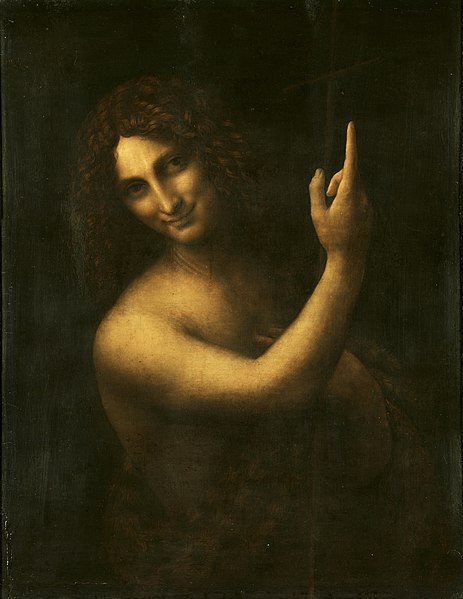
Leonardo da Vinci'due south Saint John the Baptist is an oil painting on walnut wood. Information technology was finished in 1516 and is part of da Vinci's last serial of paintings before his death.
The image of John the Baptist is shown in solitude in the painting using chiaroscuro, with the figure seeming to emerge from the night properties. The saint is clothed in furs, has long curly hair, and smiles enigmatically, reminiscent of Leonardo da Vinci'due south renowned Mona Lisa.
It recently underwent an intensive ten month restoration procedure, despite being varnished regularly it had not had an proper restoration since 1802
One of the main goals of this restoration effort was to remove well-nigh 15 coats of varnish that had yellowed and obscured the original painting's nuances and color.
Source: https://www.artst.org/leonardo-da-vinci-paintings/
0 Response to "What Works of Art Was Leonardo Da Vinci Famous for"
Publicar un comentario